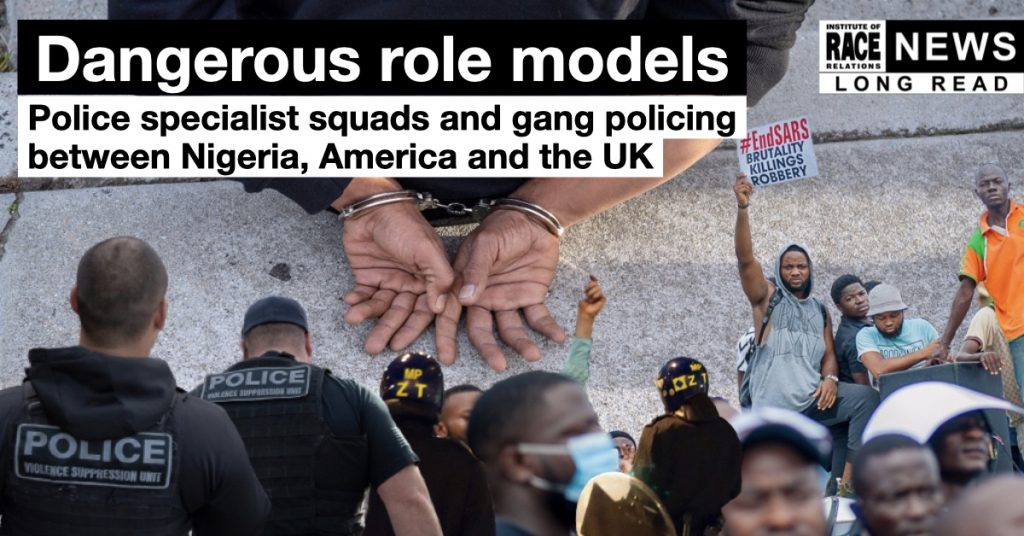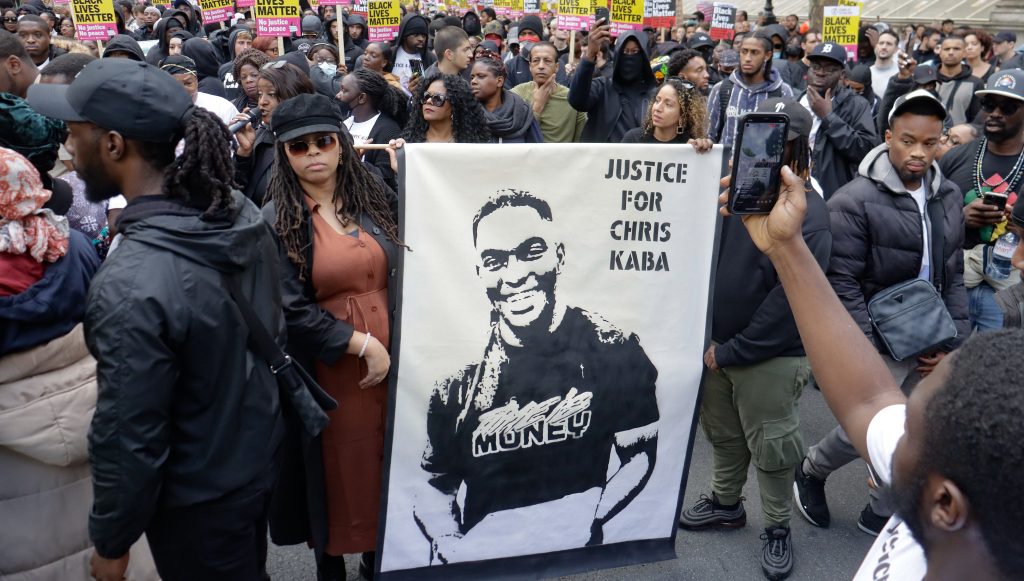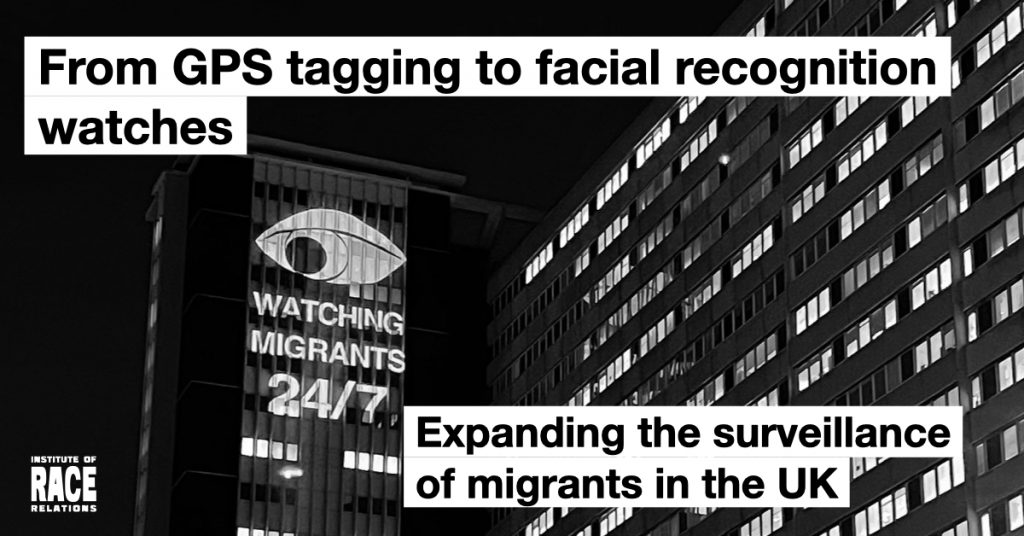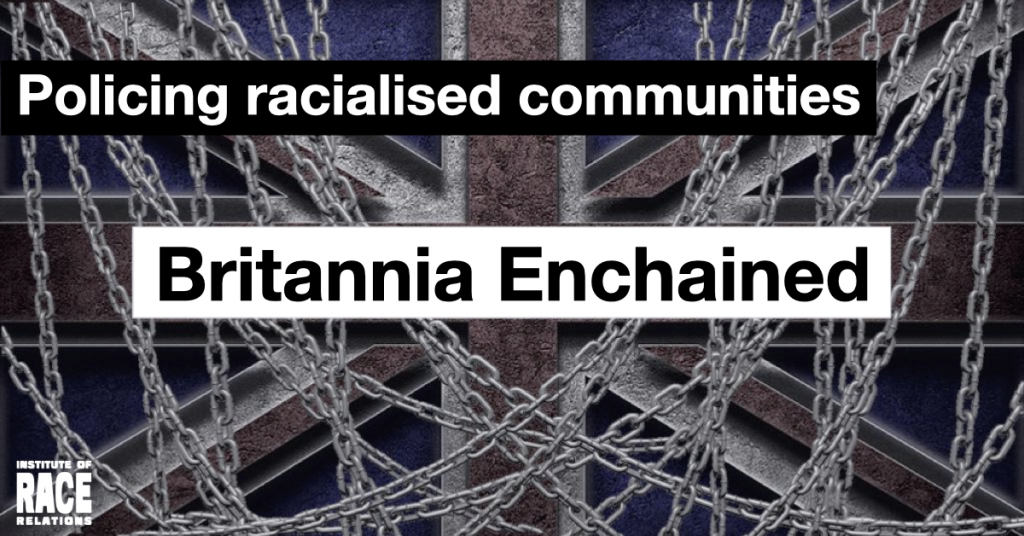As abolitionist ideas spread through communities and movements at the sharp end of policing, the police state is already here in neighbourhoods housing Black and Muslim communities in particular – working-class or inner-city areas: massive and increasingly violent policing on the streets, with Violence Suppression Units working ‘microbeats’ where ‘gangs, drugs and violence have flourished’, according to the logic of spatialised racial profiling; the threat of police violence, perhaps lethal, out of nowhere or as a response to psychological crisis or a domestic row; over-criminalisation of cannabis possession, one of the reasons for the wildly disproportionate stop and searches; electronic surveillance through facial recognition, automated numberplate recognition, fingerprint scanners; police embedded in schools, metal detectors, strip-searches, hair, dress and extremism policing; social media surveillance profiling for gang or protest-related affiliation.

The revelation that a 15-year-old schoolgirl, Child Q, had been strip-searched at her Hackney school during her period in 2020, and another menstruating girl left suicidal in December 2020 after allegedly being handcuffed and having her underwear cut off with male officers present, opened to public scrutiny a practice as regular as it is degrading. The Met strip-searches five children a week, over half of them black, often with no adult present, according to a critical report by the Children’s Commissioner, and nationwide, at least 3,000 children were strip-searched in 2021, one-third of them black. (Figures for 2022 are not yet available.) Research revealed in January 2023 that there are now nearly 1,000 police officers permanently embedded in schools, with most in poor areas with higher numbers of BME students, and plans to increase these numbers by 7 percent. Called Safer Schools Officers (SSOs), they act as a point of contact with teachers and may be involved in searches and surveillance.

Allegations of excessive force included a 14-year-old asthmatic black boy forced to the ground and handcuffed on his way home from school, a black Muslim schoolgirl left with bruises as police forced her into a commercial building to search her; a 16-year-old Muslim schoolgirl surrounded by 14 police vehicles and handcuffed, a 21-year-old pinned to the ground and punched repeatedly. When disciplinary action is taken, it rarely leads to dismissal: although an officer who punched a handcuffed black boy in the face in 2021, calling him ‘scumbag’, was fired, another, who stood on the leg of a 16-year-old boy and tasered him was not sacked, but received a ‘final warning’.
in June, 41-year-old Oladeji Omishore, who was suffering a mental health crisis, died jumping into the Thames after police tasered him multiple times on Chelsea Bridge. In September, 24-year-old father-to-be Chris Kaba was killed by a single shot to the head from a police firearms officer through the windscreen of the car he was driving in Streatham, although he was not a suspect. The officers who tasered Omishore remain on duty, and are being treated as witnesses; they have not been interviewed under caution. The officer who killed Kaba was only suspended a week later, after a public outcry. And in October, an unnamed mixed-race man died in Waltham Cross, Hertfordshire, after being sprayed with PAVA spray.

The Independent Office for Police Conduct (IOPC) warned in April that the abuse of stop and search was so serious that black and ethnic minority people needed protecting. It was causing trauma among those subjected to it, the police watchdog said, citing the case of a black teenager who had been stopped and searched 60 times in the past two years. Black people were also disproportionately handcuffed and subjected to force during stops, it found. Despite the warning, incidents such as the entrepreneur stopped and handcuffed twice in six days (the first time for wearing an overcoat on a sunny day), and further warnings of racial bias from her own civil servants, in May home secretary Priti Patel lifted restrictions on suspicionless stops in areas where serious violence may occur, having refused to publish the assessment of a pilot earlier in the year: Black people are 18 times more likely to be subjected to these ‘section 60’ stops. (For good measure, Patel gave special constables powers to use Tasers.) Racially disproportionate stops and searches violating international human rights equality obligations continued to be reported in areas including the West Midlands and Yorkshire, as well as the Met, where the HMICFRS found in September that officers were failing adequately to record grounds for stops. But rather than address the institutional racism creating such disproportion, the Met announced in October that officers would no longer record the ethnicity of drivers whose vehicles were stopped and searched.
Structural racism was apparent, too, in the disproportionate use of ankle tags on black men, according to a report from the London Mayor’s Office. The complaints of illegality and racism surrounding the notorious Gangs Violence Matrix were vindicated as a legal action by Liberty resulted in an admission by the Met that it breached privacy and non-discrimination rights, with black people put on the list for who they knew and where they lived, and the data going to housing providers, local authorities, school and the DVLA. And in the face of an alarming increase in far-right violence and referrals to the Prevent ‘anti-extremism’ programme, Sunak indicated his intention, during the Conservative leadership campaign, to refocus Prevent on ‘Islamist extremism’.
Louise Casey’s interim review of the Met, published in October, found ‘systemic’ racism and sexism, with officers suspected of serious criminal behaviour staying in post, while black recruits were far more likely to face disciplinary action and twice as likely to be fired. Yet in their ‘race plan’, police bosses in England and Wales refuse to admit the existence of institutional racism. The Chief Inspector of Constabulary Priti Patel appointed in June made a point of opposing ‘wokery’ in the force. Suella Braverman, Patel’s successor as home secretary, exhorted police to focus on ‘common sense’ policing, not anti-discrimination or ‘symbolic gestures’.
Misogyny in the police, like racism, has deep roots. HM Inspectorate found a ‘predatory’ culture towards female colleagues and members of the public, enabled by vetting failures in recruitment allowing people with criminal convictions for sexual offences and links with organised crime to join up. New commissioner Mark Rowley admitted to ‘hundreds’ still in the force who should have been dismissed – one of whom, an ‘elite’ Met firearms officer who raped dozens of women over 17 years, remained in post despite repeated allegations until his conviction and sacking in January 2023.
Provisions in the Police, Crime, Sentencing and Courts Act to criminalise Gypsy, Roma and Traveller communities, by making unauthorised encampments illegal and allowing police to seize vehicles, remain largely unused, in part because of the encouragement the Court of Appeal gave local authorities in January 2022 to issue injunctions against ‘persons unknown’ which put new arrivals at unauthorised sites in contempt of court. The court had earlier stopped the proliferation of wide injunctions, saying they were a ‘feeding frenzy’ by local authorities which was making it impossible for GRT communities to continue their way of life.
Digital policing in the surveillance state
In March, the High Court ruled that the blanket seizure of Channel crossers’ phones and pin numbers as they arrived was unlawful, and in a further judgment in October, the Home Office received a stinging rebuke for its attempt to cover up the policy, in breach of its duty of candour in legal proceedings. The court ruled that thousands of victims of the illegal seizures could be entitled to damages. And an FOI request revealed that the Information Commissioner’s Office had rebuked the Met for video surveillance of children as young as ten taking part in a climate strike protest in March 2019. Around ten thousand children took part in the School Strike for Climate, and the Met deployed two evidence-gathering teams equipped with digital camcorders capable of livestreaming to police control rooms. Big Brother Watch complained, and the ICO’s investigation found a breach of the first data protection principle. In May, the ICO fined facial recognition company Clearview AI £7.5 million for amassing billions of images from social media for a global facial recognition database, selling the service to police and others. But the following month, we learned that that the Met police routinely scour social media for children’s personal data to conduct ‘profiling on a large scale’, largely of black children suspected of gang affiliation.
Digital policing offers the possibility of continuous and total surveillance of those deemed risks to ‘public order’ or ‘national security’. Nearly twenty years ago Magnus Hörnqvist, in ‘The birth of public order policy’, noted the shift in the state’s use of force, accelerated by the war on terror, from ‘traditional crime policy’ based on demonstrable criminal offences to perceived threats and risks’, resulting in a massive expansion of institutions involved in policing, prison, border control and of the private security industry. This ‘risk-based’ policing, which requires no proof of guilt, is now commonplace, manifesting itself in areas from stop and search, the gangs matrix and ASBOs and CPOs to TPIMs and even preventive deprivation of citizenship.
We have seen how this has led to the conscription of civil society in the fields of terrorism and ‘extremism’ (the statutory ‘Prevent’ duty to report signs of ‘extremism’). The policing of risk, based as it is on what must in the end be subjective judgment, is particularly vulnerable to racial bias, as the wildly disproportionate ‘stop and search’ figures show – and the reproduction of racial bias in algorithms and in facial recognition is well known. The March report of the Lords Justice and Home Affairs Committee on the accelerating use of technology in criminal justice, Technology rules? The advent of new technologies in the justice system, cited the discriminatory impact of algorithmic ‘crime predictors, as well as the chilling effect of live facial recognition technology on freedom of assembly and association, as examples of the ‘real and current risk to human rights and to the rule of law’ posed by the use of advanced technologies in the absence of rationalised, centralised oversight and governance and a rigorous legal framework. There is no sign of either.
Meanwhile, electronic monitoring in the immigration field has expanded hugely, with GPS ankle tags for ‘high harm foreign offenders and national security risks’ piloted in June on spontaneous asylum seekers. First used in the American criminal justice system, in the UK they have been used since 2019 to monitor knife crime offenders released from prison (targeting mainly young black men, according to a report by the London mayor’s office), since extended to perpetrators of serious domestic violence and alcohol-related crime (‘sobriety tags’ monitor wearers’ sweat to calculate blood alcohol levels). Ankle tags are highly visible and stigmatising, and all GPS devices track the wearer’s precise whereabouts 24 hours a day and must be kept charged on pain of imprisonment. They have been described as ‘criminalising, dehumanising and degrading’, and catastrophic for the mental health of vulnerable wearers, one of whom, who had been tortured and trafficked in Sudan and Libya, has launched a legal challenge. If ankle tags are ‘unsuitable’, bailed foreign offenders will be required to wear facial recognition smartwatches on which to photograph themselves up to five times a day, or carry fingerprint scanners, receiving alerts throughout the day to submit their biometrics.

The Home Office ‘digital by default’ policy – digitisation of evidence of residence rights, with a ban on the use of paper documents and penalties for landlords and employers who accept them, has led to loss or refusal of work, NHS treatment and welfare benefits to thousands of people renewing visas – where applications take an average 11 months to process. The project is a testbed, and migrants the guineapigs, for the digital identity verification scheme set out in the Data Protection and Digital Information Bill, which extends data sharing between public and private sector organisations and removes many safeguards (‘barriers’ to the smooth flow of data between government agencies and third parties), to create a ‘digital surveillance state, and extending automated decision-making – overriding warnings of bias and discrimination.
The habit of surveillance is catching. In June 2022, environmental activists, who had booked to attend the annual State of London debate – an event billed as a chance to quiz the mayor Sadiq Khan on GLA policies – to question him about the Silvertown Tunnel project, were personally identified and barred from entering by O2 security guards. In October, an immigration Tribunal ruled unlawful ‘routine’ demands by local authorities that age-disputed asylum claimants hand over social media login details. Children arriving in the UK alone are, meanwhile, routinely photographed and fingerprinted by police in what is described as a ‘safeguarding’ operation to prevent trafficking; and in November Braverman announced that Xrays will be used to assess the age of asylum seekers claiming to be children, although they are no more reliable or safe now than they were when they were abandoned over forty years ago.

